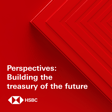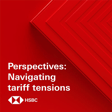Become a Creator today!Start creating today - Share your story with the world!
Start for free
00:00:00
00:00:01

DigiTalks: Bolting the Stable - The Future of Stablecoins
In our DigiTalks podcast series last year we’ve previously discussed Stablecoins. We are now featuring a part 2, as this has proved to have been very topical with a vast amount of activity in this space since then, including a newsworthy stablecoin failure prompting a cryptocurrency crash, and resultant regulatory activity to protect markets and investors.
Listen to Mhairi Sandeman, Senior Product Manager for Trustee & Fiduciary Services and Regulation, Securities Services and James Pomeroy, Global Economist, Global Research, as they discuss the future of stablecoins.
Hosted on Acast. See acast.com/privacy for more information.
Transcript
Introduction to HSBC Global Viewpoint and GigiTalks
00:00:00
Speaker
Welcome to HSBC Global Viewpoint, the podcast series that brings together business leaders and industry experts to explore the latest global insights, trends, and opportunities.
00:00:12
Speaker
Make sure you're subscribed to stay up to date with new episodes.
00:00:15
Speaker
Thanks for listening, and now onto today's show.
00:00:22
Speaker
Welcome to the latest in our GigiTalks podcast series.
00:00:26
Speaker
We are featuring a variety of different topics that are currently trending in the digital world.
00:00:32
Speaker
For the ones that have been following our podcasts, you will remember our first podcast on stablecoins last year.
00:00:39
Speaker
We are now featuring a part two where we will discuss the future of stablecoins.
Understanding Stablecoins: Risks and Rewards
00:00:45
Speaker
Introducing the topic, it's HSBC Security Services, Senior Product Manager for Trustee and Fiduciary and Regulation, Vary Sandeman.
00:00:54
Speaker
Vary, over to you.
00:00:56
Speaker
Thanks, Gabriella.
00:00:58
Speaker
Now, as you said, we've previously discussed stablecoins in our Digitox podcast series, including their risks and rewards.
00:01:06
Speaker
And this has proved to have been very topical with a vast amount of activity in the space since then.
00:01:13
Speaker
including a newsworthy stablecoin failure, which prompted a cryptocurrency crash and resultant regulatory activity to protect markets and investors.
00:01:24
Speaker
To explore and analyze these recent developments, I am delighted to welcome back James Pomeroy, global economist at HSBC's Global Research.
00:01:35
Speaker
James, thanks so much for joining me again today.
00:01:38
Speaker
Now, could you firstly remind us, please, what a stablecoin is?
00:01:43
Speaker
Of course.
00:01:43
Speaker
Well, firstly, thank you very much for having me back on the podcast.
00:01:46
Speaker
And as you said, there's a lot more awareness of stablecoins since we last spoke, but essentially in the very sort of simplistic way.
00:01:54
Speaker
While a lot of people will have heard of cryptocurrencies such as Bitcoin or Ethereum,
00:01:59
Speaker
Stablecoins are generally less well known.
00:02:01
Speaker
And then the original idea behind something like Bitcoin was to be used as a means of payment.
00:02:07
Speaker
But they've really generally struggled to become a widespread means of payment because they're generally not very good at it.
00:02:13
Speaker
Either the transaction costs are very high or not very many transactions.
00:02:18
Speaker
can be processed very quickly or very importantly, the prices of these coins are very volatile.
00:02:23
Speaker
So if you have something that's highly volatile, it's not really likely to be widely used as a means of payment because businesses don't want to accept them and consumers are pretty reluctant to use them.
00:02:34
Speaker
So a stable coin solves a lot of these issues.
00:02:36
Speaker
They can use fast blockchain networks, but the price is stable relative to a given fiat currency.
00:02:42
Speaker
So that's usually the USD, but it could be another currency if you wanted it to be.
00:02:47
Speaker
And they're backed by assets, so typically cash or bonds in that currency.
00:02:51
Speaker
So essentially, it means that it's not really pegged to that dollar or pound in the same way as any other fiat currency would be.
00:02:59
Speaker
It's generally a separate blockchain that you pay for in your fiat currency and you can guarantee the same amount out.
00:03:05
Speaker
So you're talking about an asset here that's designed to make the most of the technology behind cryptocurrencies, but not suffer from the same challenges in terms of being used as a means of payment.
00:03:15
Speaker
Thanks for explaining that James.
00:03:17
Speaker
And before we talk about the specific algorithmic stablecoin failure that occurred in May 2022, could you describe what the risks are with the more standard fiat backed stablecoins, please?
00:03:31
Speaker
So essentially, while you think about cryptocurrencies having a volatility issue, so either very volatile and therefore people don't want to use them as a means of payment with a stable coin, you're talking about a credit risk instead.
00:03:42
Speaker
And so you're essentially trusting that the issue of that stable coin has the assets that they say they do to back up on the stable coin that they're issuing.
00:03:51
Speaker
And that may not be as regulated as tightly as it maybe should be.
00:03:54
Speaker
So that's fine for small transactions if you're only making a small cross-border payment.
00:03:59
Speaker
So the most common widespread use case of stablecoins is for things like remittances.
00:04:05
Speaker
So this is pretty easy to use.
00:04:08
Speaker
But actually, as you go sort of a bigger size of payment, these credit risk problems could become slightly more concerning.
00:04:16
Speaker
So as stablecoins are a form of private money, it doesn't need to be regulated.
00:04:20
Speaker
Commercial banking
00:04:22
Speaker
system as it stands is that money is anchored by central bank money and closely regulated.
00:04:27
Speaker
That isn't really the same case with stablecoins.
00:04:30
Speaker
So we really need to make sure that stablecoins are exactly that stable.
00:04:36
Speaker
And that partly could be from regulations tightening up.
00:04:39
Speaker
It could be depending on who's issuing them.
00:04:41
Speaker
So if you think about some of the
00:04:43
Speaker
larger stablecoins that are out there.
00:04:45
Speaker
Many of the businesses behind them aren't exactly widely known.
00:04:49
Speaker
And that's why stablecoins are quite interesting because we've got a means of payment here that on paper is very, very interesting.
00:04:57
Speaker
It could be very fast, very effective means of payment.
00:05:01
Speaker
But it's the trust, it's the lack of trust in those issuers, the lack of regulation,
00:05:06
Speaker
that makes things a little bit more challenging and a stopped adoption really taking off.
00:05:10
Speaker
And that could change in the coming years with a combination of regulations, new issuers, and we could see stablecoin usage pick up quite quickly.
00:05:19
Speaker
But at the same time, that may not be enough.
00:05:21
Speaker
And it may be that stablecoins continue to exist as only having sort of niche use cases within the economy.
00:05:28
Speaker
So, so much comes down to that evolution on the regulatory side.
00:05:32
Speaker
Thanks very much, James.
00:05:33
Speaker
Really interesting considerations there.
Impact of TerraUSD Crash and Regulatory Responses
00:05:36
Speaker
And just going back now to May 2022, we had the crash of TerraUSD, the algorithmic stablecoin, and its secondary or sister token, Luna.
00:05:47
Speaker
This then had a hugely negative impact on the price of Bitcoin and other cryptocurrencies.
00:05:54
Speaker
Can you briefly explain what is different about an algorithmic stablecoin and talk us through the Terra events that occurred, please?
00:06:02
Speaker
Of course.
00:06:02
Speaker
So the main difference is that they're not backed by assets in quite the same way.
00:06:06
Speaker
So a collateralized stablecoin uses the assets as a stabilization mechanism.
00:06:11
Speaker
So all of those bonds and cash held by the issuer, whereas an algorithmic stablecoin uses data to control supply and that supply is what maintains the peg.
00:06:23
Speaker
The problem is the peg can fall if the data going into it are poor.
00:06:27
Speaker
So essentially the data that goes into that algorithm to control supply, if that data isn't perfect in terms of quality or timeliness, then the stablecoin can start to de-peg.
00:06:39
Speaker
So the problem with Terra, in the most simplistic way possible, was that the stablecoin UST had this sister coin, Luna.
00:06:46
Speaker
They were always worth one unit of another.
00:06:48
Speaker
So when confidence fell in Terraform Labs and the peg broke, which was arguably due to a couple of large withdrawals and the algorithm started kicking in, both Luna and UST entered a spiral where the algorithm kept printing more Luna tokens to remain that peg,
00:07:03
Speaker
That hurt the value of Luna and pulled down UST and so on and so on.
00:07:06
Speaker
So it almost started this downward spiral between the two stable coins.
00:07:11
Speaker
And that's where the algorithmic stable coin process really did become unstuck.
00:07:17
Speaker
Okay, thank you, James.
00:07:18
Speaker
Now, when we last spoke in early 2022, we already had emerging regulation globally around stablecoins and cryptocurrencies more broadly.
00:07:28
Speaker
The EU had been leading the charge with MICA, the Markets and Cryptoassets Regulation, which measures include introducing controls for stablecoin issuers and trading.
00:07:39
Speaker
And we're also seeing regulatory proposals around stablecoins emerging in the UK, US and in Asia, including Hong Kong and Singapore, either within existing regulatory frameworks or in bespoke regimes.
00:07:54
Speaker
The proposed regulatory approach in Singapore, for example, is unique in many aspects as it requires no additional licensing for regulated financial institutions in Singapore to issue their own G10 currency stablecoins.
00:08:09
Speaker
Of course, many of the regulatory proposals and progress have been further enhanced in response to the Terra event.
00:08:16
Speaker
James, are these regulatory developments likely to be sufficient to protect stablecoin investors and the wider market in the future?
Future Regulatory Needs and Central Bank Digital Currencies
00:08:25
Speaker
So we're going to need two big forms of regulation.
00:08:27
Speaker
I think firstly, it's going to be on the stable coins themselves to make sure that we're on top of how they're being used and how they're being traced.
00:08:34
Speaker
That's mostly so that regulators feel comfortable with them being more widely used in a lot of financial transactions.
00:08:40
Speaker
And then, of course, on the issuers.
00:08:42
Speaker
So making sure that the issuers themselves are trustworthy, that they have the assets that they say they do.
00:08:48
Speaker
And really, we can trust that these stable coins are, going back to that same phrase, exactly that, that they are stable.
00:08:54
Speaker
And if you have that and you have sort of better issuers, then you help to avoid some of the issues we've seen with stablecoins over the past year or so.
00:09:02
Speaker
And therefore, you could make stablecoins be something that people are much more comfortable putting their money into using for transactions.
00:09:08
Speaker
And we could see the role of stablecoins increasing in the global economy, despite all of the challenges that have been faced over the course of the past year.
00:09:19
Speaker
And I recall in our last discussion, James, you said the issuer risk for stablecoins could be reduced or resolved if the issuer was a central bank.
00:09:28
Speaker
So in other words, a central bank digital currency or CBDC.
00:09:32
Speaker
Do you still see this as a solution if regulation is not enough to ensure the stability of stablecoins?
00:09:40
Speaker
Yes, I think this is essentially where we're heading in terms of payments globally.
00:09:44
Speaker
So if you start right the way back with a cryptocurrency that has the problem of volatility, then you get a stable coin that solves the volatility problem but has a credit risk problem.
00:09:52
Speaker
Well, if the issue is a central bank, you remove that credit risk problem.
00:09:55
Speaker
So we're a big fan of central bank digital currencies and where we're likely to head.
00:10:00
Speaker
And more central banks are starting to think about this quite seriously.
00:10:03
Speaker
So either due to declining cash usage, such as somewhere like Sweden, wanting to minimize financial stability risks.
00:10:10
Speaker
So that's a key part of the People's Bank of China's reasoning or wanting to increase financial inclusion.
00:10:15
Speaker
And this is key in most of the emerging world.
00:10:18
Speaker
So central banks in the likes of Brazil and India really stepping up their interest from that perspective.
00:10:25
Speaker
But however you get there, the end result is going to be probably the best form of payment you could ever have.
00:10:30
Speaker
So you can have a means of payment that is costless, instantaneous.
00:10:34
Speaker
And that's pretty exciting and what that does to the global economy.
00:10:37
Speaker
You have no payment charges.
00:10:39
Speaker
What that does in terms of being a huge productivity gain, it could lift growth.
00:10:44
Speaker
It could pull billions of people into digital payments who don't have access to them today.
00:10:49
Speaker
And all of that is quite enhancing for the global economy.
00:10:53
Speaker
But we are some way off.
00:10:54
Speaker
Central bank digital currencies are not easy to develop, mostly because there's a huge number of questions that need to be answered by central banks when they build them.
00:11:02
Speaker
So we could do an entire separate podcast on those issues.
00:11:05
Speaker
But in the interim, there may be a role for stable coins.
00:11:07
Speaker
So policymakers will be paying even more attention to them in the coming years, at least while central banks are grappling with these questions about whether a central bank digital currency should be
00:11:19
Speaker
interest or how anonymous it should be and a lot of these questions are very hard to answer so there may well be a role for stablecoins in the global economy for quite some time.
Conclusion and Invitation for Further Insights
00:11:28
Speaker
James, thank you so much for joining me again today to revisit the topic of stablecoins.
00:11:34
Speaker
It's been fascinating to explore the real market examples and the regulatory responses to these.
00:11:40
Speaker
Again, a subject we will continue to watch closely.
00:11:43
Speaker
As always, if clients have any questions, please follow up with your HSBC representative.
00:11:49
Speaker
Gabriella, back over to you.
00:11:51
Speaker
Thanks.
00:11:53
Speaker
Thanks so much, Varian James.
00:11:54
Speaker
Again, a really interesting take on stablecoins and I would say stablecoins part two, right?
00:12:00
Speaker
I would like to thank you for listening to this edition in our series of DigiTalks podcasts.
00:12:05
Speaker
We hope that you enjoyed learning more about stablecoins.
00:12:08
Speaker
Stay tuned for more from our podcasts as we explore more trends in the coming weeks.
00:12:14
Speaker
Thank you for joining us at HSBC Global Viewpoint.
00:12:17
Speaker
We hope you enjoyed the discussion.
00:12:20
Speaker
Make sure you're subscribed to stay up to date with new episodes.

















